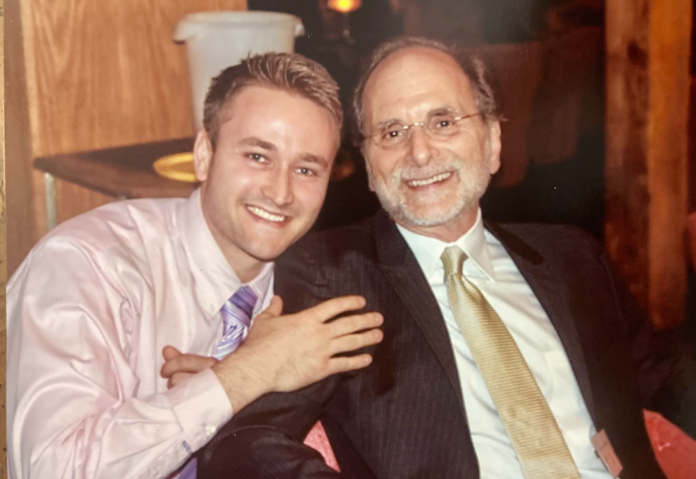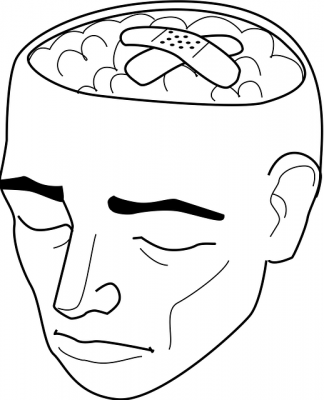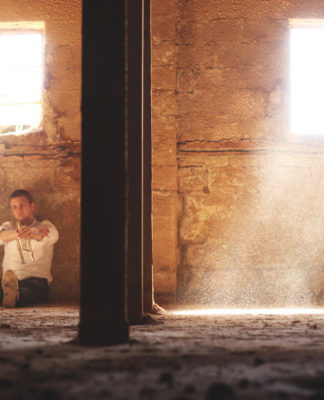Contents:
- Background
- The felt sense of connection, the two tiers of mobilization, and openness to going outside of the ISTDP roadmap
- Troubling trends
- Technique as an important background element, and the central role of the head-on collision
- Premature pressure is problematic
- Creativity
- Supervision and Teaching
- In closing
Background
Though this text is ultimately about my own perspective, this perspective has indeed been very influenced by Marvin Skorman (he wishes to be named simply “Marvin”). Therefore I want to briefly mention a few things about him, his background, and our relationship.
As Marvin’s time as a teacher draws to a close (after nearly 42 years in the field), I am reflecting back on the years we have had together. I met him in 2007, learned informally from him till 2012, at which point I began weekly audio-visual supervision as well as core training with him.
As far as I can tell, his perspective on practicing and teaching ISTDP is unique. I use the term perspective to suggest a particular flavor and emphasis, and as an acknowledgment that there are likely differences in degree, if not in kind, between how Marvin has adapted ISTDP to fit with his personality and intuitions and what may be termed orthodox ISTDP. I imagine that most practitioners and teachers, even those who aim to adhere rather strictly to a Davanloo-esque approach, adapt the model to some degree or another to fit with their own temperaments.
Marvin was one of Dr. Davanloo’s right-hand men in the 1980s, had a falling out with Dr. Davanloo in 1991, and the two reconnected in 2012. Mr. Skorman worked briefly with Dr. Davanloo again in 2015. Since the 1980s Mr. Skorman remained in close collegial contact and collaboration with James Schubmehl, MD and Deborah J. Lebeaux, CSW, both students of Dr. Davanloo.
He has eschewed the limelight (i.e., having him give his seal of approval to this text was a pain), he has felt repelled by some of the “seeking and finding religion” culture that can be connected with ISTDP, and besides the little professional association in Rochester, NY with Schubmehl and Lebeaux, he has not wanted to be associated with any institutions or associations, though he is clear that he believes institutes have their place as bodies of knowledge and serve an important function in offering historical continuity.
He coined the term “ISTDP attachment disorder,” cementing his strong emphasis on flexibility and concern around formulaic treatment. The issues with being overly rigid and formulaic are not unique to ISTDP, but can apply to any therapeutic modality.
What I have learned and have carried with me from the years of core training and audio-visual learning from Marvin may be different from his other students and trainees, which in itself speaks to what it is like to train with him. Having had years of both individual and group supervisions with Marvin, it is clear that he approaches everyone differently.
Some of my training experiences have also helped me clarify where I depart from Marvin in terms of emphasis, so my perspective is influenced by him, a product from working with him, but contains my own adaptations, elaborations, and colorations from other teachers, peers, and studies.
What follows is my assessment of the key take-aways that I have absorbed, carry with me, and have incorporated into how I practice and teach Intensive Short-Term Dynamic Psychotherapy (ISTDP).
The felt sense of connection, the two tiers of mobilization, and openness to going outside the ISTDP roadmap
A phrase Marvin sometimes uses that I has stuck to my ribs: “Therapy is about two imperfect human beings — each with their own triangle of conflicts —working out a relationship.” Nothing supersedes maintaining this felt sense of connection to the patient, which includes factoring in who we are and who the patient is at any given moment in time. This includes being connected to ourselves as therapists in the session — aware of what is happening inside of us, helping the patient be aware and convey to us of what is happening inside of them, and directly addressing any barriers that eclipse this awareness and emotional closeness. What maintains this connection can vary a great deal: for some it may look very supportive, for others it may look like heavy pressure and systematic challenge. When this is accomplished, not perfectly but sufficiently, the treatment outcome will be positive, no matter which therapeutic modality is used.
I have found that for me and many of my students, what goes into making and maintaining this emotional connection typically involves frequent recapping and clarification work, always making sure that the therapist can picture precisely what the patient is saying, to the point where the therapy session takes on the sensation of patient and therapist “sharing the same dream,” to use Marvin’s terminology. I place a tremendous value on dynamic inquiry and exploration, which I believe myself to see repeatedly in a host of Davanloo’s transcripts (H. Davanloo, Unlocking the Unconscious, 1990, and Intensive Short-Term Dynamic Psychotherapy: Selected Papers of Habib Davanloo, 2000).
A sign that this connection is happening is that therapist and patient nod along together, sometimes even finishing each other’s sentences. It includes agreement around goals and the therapeutic task, but it goes beyond that. The patient should have the sense that the therapist is in their corner, and a sense that the therapist is concerned with their suffering. When this goes well, the patient does not experience the therapist as laying a trip on them, as pushing an agenda on them, and this sense of collaboration and togetherness continues even during heavy pressure and challenge (when and if heavy pressure and challenge is called for).
Not until the process of getting a clear phenomenological, descriptive picture of the presenting problems as well as the patient’s emotions is impeded by resistance does inquiry stop and give rise to focused defense work (prior to this juncture, tactical defenses may be briefly commented on). This can of course happen right out of the gate in the first minute of the first session, or further down the road — depending on rightward or leftward location on the psychoneurotic or fragile spectrum. Depending on ego-adaptive capacity, what “focused defense work” looks like varies a great deal.
It is important to underscore that some level of mobilization of the patient’s unconscious affective system is desired even during the phase of inquiry, but I distinguish between organic, lower level mobilization (tier one) and higher level mobilization (tier two) through targeted forms of added pressure on the foundation of a conscious therapeutic alliance. More on what I mean by added pressure in a minute. If I learned but one thing from Marvin, it was to not move to the second level of mobilization until there has been sufficient work done on the conscious therapeutic alliance, and when a graded format is called for, this added pressure is graded indeed (J. Whittemore, 1996).
Another prominent feature in the flavor of ISTDP that I have internalized is that even when a patient has the ego-adaptive capacity to face the de-repression of the unconscious, I do not automatically press ahead towards an unlocking. Some patients with higher ego-adaptive capacity want to take the edge off their symptoms and, in spite of seeing the down side of their defenses, are not interested in reaching “the top of the mountain,” so I go with what the patient is clear on that they want and thereby avoid a battle of wills scenario or a situation where I end up pushing an agenda on the patient.
I may say to a patient, “You have clearly made a lot of progress, but there are also signs you are not out of the woods fully. Is this good enough for you?” The patient may say that it is. If the patient has a track record of selling themselves short and not being honest about what they really want in their heart of hearts, I may press a bit, “are you sure? Are you settling in a way that sells you short?” But at the end of the day, if the patient says that where they are is good enough for them, then it is and I accept that.
There may also be sessions dedicated to taking a victory lap, celebrating the progress in the patient’s life, perhaps even ending the session early because the patient is wanting to just enjoy where they currently are, knowing that next week they may again wish to dig deeper. Bottom line: regardless of the patient’s capacity, I do not get ahead of their conscious will and I am open to the possibility that for some patients, unlocking the unconscious is just not where it is at for them, and other, different types of therapeutic work is what is needed. Remaining in touch with not just overt psychodiagnostic information but also with my felt sense (more covert, counter transferential diagnostics) helps me make the determinations of what, when, and with whom.
I also stress the importance of arriving at a dynamic formulation of the psychodynamic conflicts giving rise to the patient’s presenting problems. The triangle of person as well as nuanced, unique themes related to the patient’s intrapsychic conflicts are a major focus in how I engage with ISTDP. I am reminded of the many times Marvin asked: “What is the formulation here?”
Troubling trends: misalliances and doctrinaire application of technique
In the context of reflecting on past mistakes, seeing what trainees struggle with, and comparing notes with Marvin, some troubling trends come to the fore (trends neither Marvin or myself are immune from). I am thinking of trainees and practitioners of ISTDP being out of step with their patients for one reason or another. Some applying well-rehearsed straight-lines and rote techniques, others so focused on looking for signs of unconscious communication that they aren’t actually hearing what the patients are saying, yet others so focused on dragging patients through the central dynamic sequence — that the foundation gets lost, the actual contact and connection between patient and therapist is often not there, replaced by attempts at applying techniques.
The basics of dynamic inquiry, understanding how the patient sees things, ensuring the therapist has properly understood the meaning of what the patient is trying to convey by summarizing and underscoring key themes with dynamic significance, establishing a conscious alliance, arriving at a formulation of the core conflicts driving the patient’s problems, these are the type of things that appear lacking and stand out as problematic themes.
I recall Marvin speculating that these issues might boil down to what he calls “the suffering of therapists.” When he gives me supervision on how I supervise trainees, he frequently makes the point that the intervention-response principle is not just for our patients, but also for our trainees. The trainee’s subjective responses to the supervision are attended to and factored into the didactics — their anxiety also needs to be in a therapeutic range and if this is not attended to — if I offer my perceptions and suggestions without regard for where the trainee is, it often creates a misalliance between us and creates suffering for the trainee. For others, a “just tell me what you see and what you would do” approach works. I learned from Marvin to meet my trainees where they are and that a conscious alliance with them is just as important as with patients.
Though Marvin truly adores Dr. Davanloo, he reflects on his core training with him and tells me that there was a major focus on unlocking the unconscious, and that he eventually came to feel that this single-minded emphasis on the unlocking of the unconscious experience sometimes came at the expense of not just the human relationship and connection with the patient, but also an openness to seeing other, unique ways of helping the patient not involving an unlocking of the unconscious, that may be more optimal. Having been trained in this way, I find it important to stay open to the collective unconscious between the patient and myself, and allowing interventions to come from that place — interventions that may be unique to a given patient at a given moment, that may never be repeated again.
During one of our discussions, Marvin shared the following with me: “Davanloo used to say, ‘With the help of each other, if we work hard, we can get to the bottom of your problems.’ That was his way of saying it [that the heart of this work is about the emotional connection and collaboration between patient and therapist].” Marvin continued: “So much of that essence of Davanloo seems to have gotten lost, the admiration and affection part, it somehow got ‘techniqued’ away. The technique was secondary for Davanloo, it came from his intuition, which I think is an invitation to all of us to use our intuition.”
Technique as an important background element, and the central role of the head-on collision
With the emphasis on emotional closeness and connection with the patient, some may think that what I learned from Marvin de-emphasizes specific techniques. This is true. Marvin really is concerned about an over-emphasis on technique and an excessive attachment to diagnostic categories that get in the way of a human-to-human connection with the patient.
Yet I have learned a great deal when it comes to assessment and technical execution. Stand-out items that come to mind: working with malignant forms of resistance where “talking down to the super-ego,” is important (super-ego as a motivational force, not a noun), not “bargaining with the super-ego,” undoing projections by being different from the projection. For example, a patient projects their super-ego functions onto me and accuses me of putting them down. A defensive response aimed at trying to get the patient to be different would reinforce the projection. A response of, “So you see me as putting you down. That is concerning, if I am doing that, that would be really bad. What makes you come to this conclusion?” asked in a sincere manner will counteract this kind of a projection. Part of the needed therapist mindset here involves staying open to the possibility that the patient’s perception may have merit.
Another important concept I have learned from Marvin has to do with not allowing patients to manipulate me out of having an opinion, or getting sucked into colluding with the patient’s maladaptive defenses, i.e., pampering, coddling, or otherwise going along with an insecure attachment with the patient (insecure attachment reference — Jon Frederickson, personal communication, 2020). Most importantly, understanding when and with whom to do what with, based on an ability to assess the patient and engage with the interactive diagnostic roadmap that Dr. Davanloo developed.
Enter the head-on collision.
Marvin has had a role in my deep appreciation for the head-on collision. I have learned about many different kinds of them depending on the patient’s ego-adaptive capacity and the strength of the conscious and unconscious therapeutic alliance. A complete taxonomy of the different types of head-on collisions that I use is outside the scope of this text, but in addition to ego-adaptive capacity and the status of the conscious and unconscious alliance, the patient’s unique history, ego-syntonicity vs. ego-dystonicity of defenses, and severity of the need for self-defeat also factor in.
For example, with a patient with signs of fragility and a history fraught with rejection and abandonment, I may leave out the “if you remain distant like this, this process is doomed to fail.” Instead I may just say with a calm, edge-free tone, “So when you are like this, you are out of reach, and we are treading water, aren’t we.” I may add, “and that is of course your right, I am not going anywhere, I am here if you decide you would like to engage.”
Fragility does not mean that I do not point out reality, but I do this in a manner that makes it very clear that I do not need the patient to change, that I am not pressuring the patient to be different — the impetus to change needs to come from them. The emphatic “why do you want to do this to yourself?” interventions are truly superb, appealing to both the conscious and unconscious alliance with pressure on the patient to do something about the resistance, but I reserve this way of working for very different contexts than the beginning work with patient’s with fragility.
A few paragraphs down under the “premature pressure is problematic” subsection, I give another example of a type of head-on collision that conveys both empathy for the patient’s conflict while still pointing out the reality that the therapist cannot be helpful while the patient remains guarded.
A different presentation, say an absence of fragility, ego-dystonic defenses, a highly malignant, destructive form of resistance may call for a head-on collision using a “talking down to tone” that not only underscores that the therapy will fail but also questions the point of even meeting, in line with what Dr. Davanloo referred to as conveying “studied disrespect” towards the defenses (H. Davanloo, Unlocking the Unconscious, 1990, p. 214).
While on this topic I cannot refrain from mentioning an article written by Allen Kalpin, MD, where he describes the head-on collision. It is titled Effective Use of Davanloo’s “Head-On Collision” (1994). The article covers a great deal about this intervention, from the “partial head-on collision with the character resistance,” to issues of timing, the differential aim regarding restructuring or unlocking, and the recognition that some forms of head-on collision are done prior to a rise in complex feelings and others after.
This article by Dr. Kalpin does a particularly good job highlighting the importance of not watering down the power of head-on collisions by being prepared and open to the fact that the patient may decide to leave and not try to change themselves. The article also does a beautiful job of underscoring use of silence, “not filling in the gaps,” the need for the therapist to not over-function, to not resist the patient’s resistance, so that when the therapist observes to the patient that therapy grinds to a halt, the patient can truly experience the halting and the self-destructive consequences of their resistance (p. 34).
The head on-collision is often critical, not just in order to undo the omnipotent transference resistance, intensify intrapsychic conflict towards the needed crisis-point, but also in order to cement and solidify the conscious therapeutic alliance and help the patient turn against her maladaptive defenses. When I help a patient see that there is a battle inside of them between the side that wants to remain guarded and the side that wants freedom, and ask the patient: “Which side are you on?” I am inviting the conscious will, I am “putting the patient at choice” to use Dr. Patricia Coughlin’s terminology (Personal Communication, 2017). When and if the patient convincingly declares that they are on the side that wants to discontinue the avoidance strategies, the patient “turns against” her defenses and the conscious therapeutic alliance is solidified.
This may clarify that I am not anti-technique or theory, but instead I am against a technical mindset getting in the way, becoming a therapist-created barrier against emotional closeness. I very much believe that it is very important to have sufficient theoretical understanding, discipline, and skill when it comes to moment-to-moment assessment of patient-response, assessing ego-adaptive capacity, and ability to effectively intervene based on these factors.
I have wished Marvin placed more value on theory, an area where we depart a bit from each other. He seems to have an ability to allow his own unconscious to connect with the patient’s unconscious and be guided by that, which I very much admire, but recognize that not everyone is able to do, giving rise to a need for theoretical and conceptual structures.
On the topic of staying present with the patient and not mechanically plowing ahead in a cook-book fashion (allowing theory and technique to get in the way), I am reminded of a comment Marvin makes from time to time: “this is intervention-response, not intervention, intervention, intervention, and ‘I’ll see you next week.’”
Premature pressure is problematic
A major principle that I have internalized is to not apply any added pressure — added as in additional pressure on top of the inherent pressure contained in inquiry into the patient’s problems and their will — without the patient having convincingly declared their will to let go of defenses in favor of facing feelings. Then again, the perceptive reader will note that in order for there to be a question of turning against defenses, some level of mobilization and pressure to affect would first need to be there.
This goes back to the two tiers of mobilization. The first tier can be achieved conversationally by simply asking about the patient’s priorities and feelings, making links, and reflecting back to the patient what is observed about their responses. The second tier is when I ratchet up the pressure but at that point I want a conscious alliance as the foundation. Moving ahead to second-tier level pressure without adequate foundational work is what is often problematic, and not something I am always immune from.
In other words, I generally do not try to get a high rise on complex transference feelings before there is a sturdy conscious therapeutic alliance and the patient has begun to turn against their defenses. Since some variety of the head-on collision is often central to helping the patient turn against her defenses, this intervention (modified to be suited to the patient in front of me) is typically done prior to a high rise of complex transference feelings, and later repeated (typically in abbreviated format so as to not deflate rise in feeling) as needed. An early head-on collision here is not meant to “block” defenses but is done conversationally and matter of factly so as to help the patient make an informed decision around holding onto or letting go of their defenses. As alluded to in the previous paragraph regarding the two tiers of pressure, some level of mobilization is typically desired and needed even prior to using added pressure and the head-on collision. Again, I cannot help a patient meaningfully turn against her defenses outside the context of some level of feelings and defenses being stirred up.
In fact, not until the stage of increasing pressure and challenge where I aim for an unlocking of the unconscious by decisively blocking all defenses (blocking everything that is not the experience of raw feeling and impulse) — aka unremitting pressure and systematic challenge — does the conversational quality of the treatment give way to what is more clearly and overtly an applied technique, though Marvin stresses that even then, if the pressure and systematic challenge fails to enhance the felt sense of connection with the patient, it may be best to hold off on these more advanced interventions until they can be done without sacrificing the sense of collaboration and closeness with the patient. This portion is not used in the graded format.
In the context of defenses and resistance impeding the progression of therapy, and the patient being reluctant to let go of their defenses, I can’t count the times I have heard Marvin very calmly say something to this effect: “I understand, allowing people close to you hasn’t been a good experience for you so far. And yet this represents a dilemma in our work, because the one thing I need in order to have a shot at being helpful to you is access to your most intimate thoughts and feelings, and it is also the one thing you say you abhor the most, letting people in, close to you. So here we are.” At these types of junctures, this is a conversation, not an attempt to mobilize complex transference feelings (though it often does).
The bottom line: without a conscious alliance around facing feelings, I don’t exert heavy pressure toward feelings. Without a conscious alliance around letting go of defenses, I don’t exert heavy pressure to relinquish defenses. Not getting ahead of the patient’s conscious will is a central tenet in how I practice and teach ISTDP. There are no repeated “so what feelings are coming up” or “how do you experience that feeling” questions until the patient is on board with such a focus and has a crystal clear understanding of how those questions (and that task) relate to their concerns and priorities for treatment.
Creativity
I really appreciate creativity. On this topic, I can think of several instances where Marvin has helped me think outside the box and be creative. Perhaps the best example of the creativity I have observed and been inspired by centers around his development of a way of facilitating couples therapy, obviously an adaptation but still grounded in ISTDP principles.
Since Davanloo developed ISTDP for individuals, with the aim of resolving intrapsychic conflict, and couples therapy primarily deals with interpersonal conflict, the adaptation component looms large, but the principles around emotional closeness and resistance against emotional closeness, and each person’s triangle of conflict are foundational in this approach to couples therapy. Unlocking of the unconscious is not the primary aim, but sometimes spontaneously occurs. The intrapsychic conflicts of the individuals comprising the couple play a major role in their interpersonal conflicts, so I attend to this dimension as well even though the couple itself is the patient.
This approach to couples therapy is elegant and often very effective (though I have no research to back that up, so it is considered experimental). A YouTube video exists that explains this approach in detail — simply type in the search words: “ISTDP Inspired Couples Therapy” on YouTube to access that video.
Supervision and Teaching
Influenced by Marvin, my approach to teaching and supervision is characterized by using who the trainee is, their life and clinical experience as a starting point, and then integrating ISTDP into that so as to enhance the trainee’s strengths, rather than trying to make the trainee void who they are in order to fit into a mold. This is hopefully how all teachers supervise, but I bring it up because of much it was stressed to me in my own teacher training.
When difficulties arise, my default assumption is that my training approach needs to be questioned or adjusted, not that the trainee is defective. Like most all trainers I assume, I encourage my trainees to find their own voice and integrate whatever they learn into their own personality.
If there is ever a choice between didactics — introducing ways of understanding what is going on with the patient and letting the trainee know what they could have done differently with their patients — or meeting the trainee where they are and modeling how to not get ahead of the patient by not getting ahead of where the trainee is, I opt for the latter, shelving didactics in favor of a conscious alliance with the trainee and modeling how to be with patients.
As previously mentioned, Marvin has remained apart from institutionalized ISTDP places of learning. On several occasions he tried to help Dr. Davanloo formalize and codify certification programs in ISTDP, but these efforts never succeeded. Without institutionalized backing, there is nevertheless a more informal practice around transmitting the recognition of readiness to teach to students in the community around Marvin. Marvin’s tenacity in fighting off my attempts to have him create something more formal has bested my efforts.
In closing
As I am writing this in 2021, I realize it’s been 14-years of intensive immersion in learning on this path, and that capturing the stand-out items of this learning is a tall order. A text like this cannot do justice to the task of trying to capture the distilled essence of what I learned.
As Marvin heads for the exit, I mourn the loss of this teacher that has been so formative for me. To my mind, our profession is losing a giant who chose to live, practice, and teach in relative obscurity. His wish has been for his students to take what they can from him but then chart their own course, keeping the flame alive but in a way that honors the uniqueness of who we are as individuals.
I raise a metaphorical glass to him, to Dr. Davanloo, who made all of this possible, and to other teachers and peers who supplement and contribute to my learning.
References and acknowledgment:
Elad Jair Chone, Clinical psych. — close student of Marvin — in an editorial capacity, has graciously assisted in the making of this text.
Marvin Skorman, LMHC, Personal Communications (2007 – 2021).
Davanloo, H. (1990). Unlocking the Unconscious (p. 3). N.p.: John Wiley & Sons.
Davanloo, H. (2000). Intensive Short-Term Dynamic Psychotherapy: Selected Papers of Habib Davanloo, MD Chichester, England: John Wiley & Sons.
Kalpin, A. Effective use of Davanloo’s “head-On Collision”. International journal of short-term psychotherapy, 9, 19-36.
Whittemore, Joan W. “Paving the Royal Road: An. Overview of Conceptual and Technical Features in the Graded Format of Davanloo’ s Intensive Short-Term Dynamic Psychotherapy.” International Journal of Short-Term Psychotherapy, vol. 11, 1996, pp. 21-39.
Dr. Patricia Coughlin, Personal Communication, (2017).
Jon Frederickson, MSW, Personal communication, (2020).


 I have a passion for practicing ISTDP informed psychotherapy and I enjoy writing about it. For more information and what I do, visit my website: www.johanneskieding.com
I have a passion for practicing ISTDP informed psychotherapy and I enjoy writing about it. For more information and what I do, visit my website: www.johanneskieding.com


















